Painting the Eyes
On this pilot you get to try to paint inside little slits. The pilot's left eye is less
than 1/16" open. The right eye is slightly more open. There's not a lot of room to work.
I
suggest you mount the pilot so it can't move and find a good seated position so you can guide the brush with
both hands.
You need a brush with an extremely sharp point. I used a
good sable Round #1 brush. A pair of magnifying glasses such as reading glasses is very helpful when
working on fine details.
How Not to Paint a Gargoyle
The biggest mistake people make when painting eyes is to paint a round iris. This is the basis of all
gargoyle-eyed pilots and it ruins the pilot every time. It's a very easy mistake to make and very easy to
avoid.
Take a moment to think about how your eyes feel right now. If you're squinting stop it. Just take
a mental snapshot of how your eyes feel when you're relaxed and just looking at something normally.
Go to a mirror and look at your eyes the same way. Don't squint and don't stare. Just look with
your eyes relaxed normally.
What you should see is that the bottom of your iris just barely touches your lower eyelid. The upper
part of your iris goes above your upper eyelid where you can't see it. Use
Google Images to search for "eyes" to see
photos of various eyes and get a good idea how they should look.
Your pupil is probably somewhat dilated if you've been indoors. Next time you're in the sun for
a while, come back in and look at your eyes again. Note the proportion of your pupil to the iris when your
pupils are constricted.
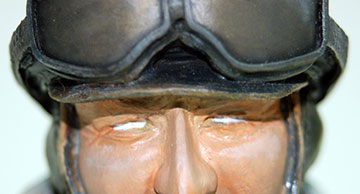 |
I used oil paints exclusively for the eyes. I thinned the paint to the consistency of melted butter so
that it would flow off the brush nicely and not clump on the tip.
Begin by using white or a very light gray to paint the entire eye. Try to avoid the inside of the
eyelids but don't worry if you get paint on them. When the eyes are finished you can use a clean brush
dipped in thinner to carefully remove paint inside the lids.
You can stop here if you have an application needing a zombie pilot although the skin tones aren't quite
right for the living dead. |
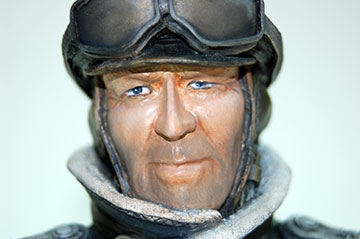 |
Begin with black oil paint for the outline of the iris. Fill in the whole area but remember that it extends
higher than the upper eyelid and just touches or maybe goes slightly below the lower eyelid. Mix whatever
color you want the iris (eye color) to be. I decided to stick with the blue eyed German cliché.
Apply the paint starting in the center of the black area and carefully working your way out. Leave a black
outline around the iris. If the iris is too small then you may need to add more black to enlarge the
outline and then add more of the iris color.
The pupil is added using a very small amount of black paint and a sharp brush. It too should be
off-center toward the top of the eye.
Lastly, a tiny drop of white is added to create a "reflection" on each eye. In studing various photos
I've noticed that the reflection often half-overlaps the iris and the pupil. Be sure the
reflection is on the same side of each eye.
It took me two
attempts to paint the left eye because I lost control of the brush and got blue all over the place. I
removed all the paint using a clean brush dipped in thinner. It's still not perfect but it's about as good
as I can get it. The more I try to "fix" things the worse I make them so I quit while I was ahead.
This photo was taken with a macro lens. From a couple feet away the eyes look very good.
|
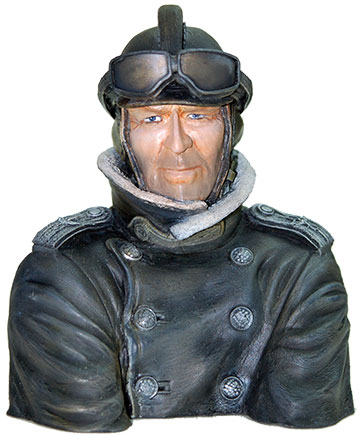 |
At this point I've touched up various items on the uniform and face. I added more highlighting on the upper cheeks and nose. I also added some random "dirt"
splatters and smudges to the jacket. More work has
been done to the goggles. The shadows are deeper to indicate farther distance to the helmet behind them.
I'm going to blend the uniform highlights some more and then give the pilot
several days to dry.
The next step is to add a flat sealing clear-coat.
|
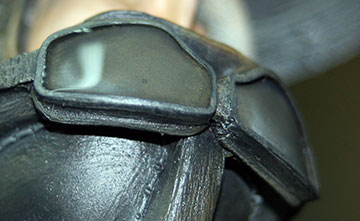 |
After the satin clear coat is dry we're ready for the last step — creating the "glass" lenses in
the goggles. I use slow-drying laminating
epoxy because regular epoxy glue gets a lot of bubbles trapped in it when it is
mixed. These bubbles are usually there to stay and visible after the epoxy is cured.
In this case I used 30-minute EZ Lam epoxy from
Aerospace Composites. Begin by placing the pilot on a bean bag or soft folded rag such that the lens is
level and the pilot can't roll.
Add epoxy to the lens one small drop at a time with a toothpick or something similar. Use the toothpick
to spread the epoxy all around the edges. Add a few more drops until the lens fills in. Don't use
too much epoxy because you don't want it overflowing to someplace you don't want it.
Do one lens at a time and allow it to fully cure then do the other lens.
|
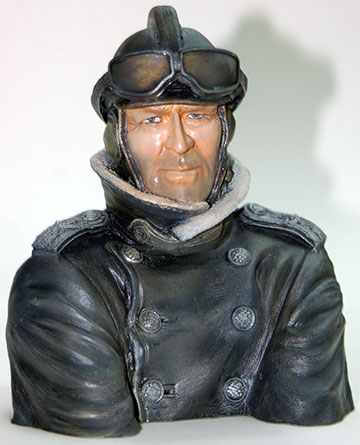 |
Sweaty Hunter in the Sky! The satin clear turned glossy on me. I hereby declare satin
clear to be my mortal enemy! |
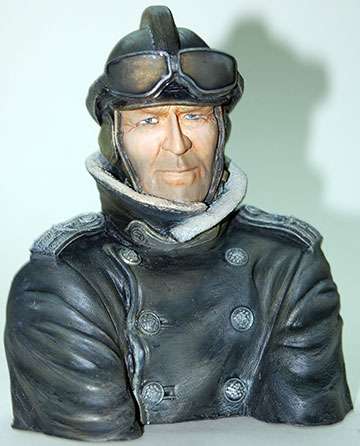 |
I mixed a flat clear using Tamiya acrylics (Tamiya flat base plus gloss clear). I sprayed
at very low pressure using my
Hansa 351 airbrush just over the face and the uniform while avoiding the goggle
lenses. It did the job. |
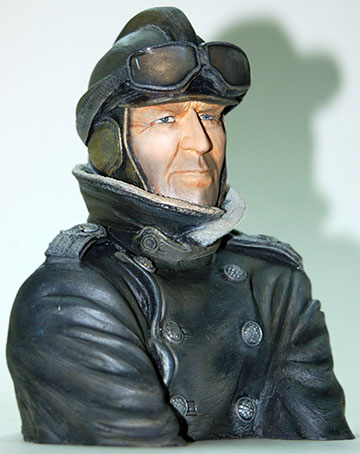 |
Who da man? Oh yeah?!? Let's see your Blue Max! |
|
![]()